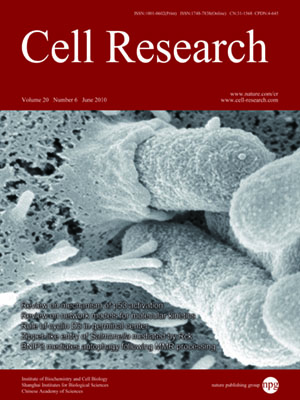
Volume 20, No 6, Jun 2010
ISSN: 1001-0602
EISSN: 1748-7838 2018
impact factor 17.848*
(Clarivate Analytics, 2019)
Volume 20 Issue 6, June 2010: 647-664
ORIGINAL ARTICLES
Rck of Salmonella enterica, subspecies enterica serovar Enteritidis, mediates Zipper-like internalization
Manon Rosselin1,2, Isabelle Virlogeux-Payant1,2, Christian Roy3, Elisabeth Bottreau1,2, Pierre-Yves Sizaret2,4, Lily Mijouin1,2, Pierre Germon1,2, Emmanuelle Caron5, Philippe Velge1,2 and Agnès Wiedemann1,2
1INRA, UR1282 Infectiologie Animale et Santé Publique, F-37380 Nouzilly, France
2IFR136 Agents transmissibles et Infectiologie, Universit?de Tours, France
3Dynamique des Interactions Membranaires Normales et Pathologiques, Centre National de la Recherche Scientifique, UMR 5235, Universit?Montpellier II, Montpellier, France
4D閜artement des microscopies plate-forme RIO, INSERM U966, Universit?Fran鏾is Rabelais, Tours, France
5Centre for Molecular Microbiology and Infection and Division of Cell and Molecular Biology, Imperial College London, London, SW7 2AZ, UK
Correspondence: Agnès Wiedemann(awiedemann@tours.inra.fr)
Salmonella can invade non-phagocytic cells through its type III secretion system (T3SS-1), which induces a Trigger entry process. This study showed that Salmonella enterica, subspecies enterica serovar Enteritidis can also invade cells via the Rck outer membrane protein. Rck was necessary and sufficient to enable non-invasive E. coli and Rck-coated beads to adhere to and invade different cells. Internalization analysis of latex beads coated with different Rck peptides showed that the peptide containing amino acids 140-150 promoted adhesion, whereas amino acids between 150 and 159 modulated invasion. Expression of dominant-negative derivatives and use of specific inhibitors demonstrated the crucial role of small GTPases Rac1 and Cdc42 in activating the Arp2/3 complex to trigger formation of actin-rich accumulation, leading to Rck-dependent internalization. Finally, scanning and transmission electron microscopy with Rck-coated beads and E. coli expressing Rck revealed microvillus-like extensions that formed a Zipper-like structure, engulfing the adherent beads and bacteria. Overall, our results provide new insights into the Salmonella T3SS-independent invasion mechanisms and strongly suggest that Rck induces a Zipper-like entry mechanism. Consequently, Salmonella seems to be the first bacterium found to be able to induce both Zipper and Trigger mechanisms to invade host cells.
Cell Research (2010) 20:647-664. doi:10.1038/cr.2010.45; published online 6 April 2010
FULL TEXT | PDF
Browse 2411


